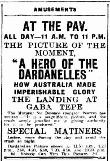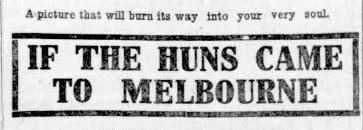AustLit
Latest Issues
AbstractHistoryArchive Description
'The film is entitled "The Hero of the Dardanelles," and is the second of a series of pictures designed to assist the inducing men to enlist. The life of the soldiers in Liverpool camp is depicted, their subsequent entrainment and embarkation for Eygpt is shown, and "The Hero of the Dardanelles" is followed through the landing on the beach and over the rocky ridges right up to the time of his being wounded. Then he is seen back in Sydney at his wedding.'
Source:
'Hero of the Dardanelles', Cairns Post, 13 September 1915, p.4. (Via Trove Australia)
Notes
-
Something of a sequel to the recruiting film Will They Never Come? (1915).
-
The Gallipoli landing was recreated at a Sydney ebach, with the assistance of military forces:
The Minister for Defence gave the production his official sanction, and placed at the disposal of the producers the whole of the New South Wales military forces. One thousand soldiers from the Liverpool camp were sent down to take part in the landing scene–enacted on a strip of coastline not far from Sydney, bearing a striking resemblance to the original landing place at Gaba Tepe. They went into it with all the vigor of their comrades at the Dardanelles, landing in the naval cutters, sweeping up the beach with fixed bayonetes, into the Turkish trenches, and up the face of the precipitous cliff exactly as reported by Ashmead Bartlett. The whole scene, it is stated, has been recorded by the camera with realism. Says one writer: 'The boys swimming under shrapnel fire or making the wild dashes that earned them the name of the "Mad White Ghurkas'' recreate those scenes of reckless courage, gallant sacrifice, and imperishable glory that marked the Australians' baptism of fire.'
Source:
'Johnson's Pictures', Barrier Miner, 31 July 1915, p.5. (Via Trove Australia)
Publication Details of Only Known VersionEarliest 2 Known Versions of
Works about this Work
-
“They Said It'd Be an Adventure” : Masculinity, Nation, and Empire in Centennial Australian World War I Film and Television
2018
single work
criticism
— Appears in: Journal of Popular Culture , vol. 51 no. 6 2018; (p. 1356-1375)'The World War I Gallipoli campaign in modern Turkey in April 1915 was calamitous from the outset, with the amphibious assault by British and Allied forces landing well off course. Australia's first major military engagement since achieving nationhood in 1901, its chief success would become their stealth evacuation, which saw seventy thousand men covertly withdrawn over nine days and nights in December 1915. The campaign was ultimately futile and deemed immaterial to the outcome of the war. Such an ignominious defeat at the hands of the Ottoman Empire would seem an unlikely source for a national myth. It lacks, for example, “the psychic reassurance of triumph over the sources of threat” and the defeat of enemies that Graham Dawson identifies as a key psychic and social function of adventure narratives and soldier heroes (282). Yet, the ill‐fated Gallipoli campaign is popularly held in Australia's cultural imagination as the “birth of a nation” for a former colony then still under the yoke of the British Empire. In Australian politics and culture, the youthful nation's presumed character was forged in war and embodied in the deeds of its young men, in spite of ultimate defeat.' (Introduction)
-
Rewind : The Making of Breaker Morant
2016
single work
column
— Appears in: FilmInk , 25 April 2016; -
American Combine : Australasian Films Ltd., and Block Bookings
2015
single work
criticism
— Appears in: Studies in Australasian Cinema , vol. 9 no. 3 2015; (p. 241-252) 'The 1927–1928 Commonwealth Royal Commission on the Moving Picture Industry in Australia followed a series of public inquiries into the Australian cinema. One agenda of the Commission was to examine the dominance of American movies in Australian film exhibition. By concentrating on how the Commission explored this issue, as it related to the exhibition and distribution of Hollywood movies in Australia, here I will consider the extent to which Australian exhibition has been guided by and dependent on American movies. With the Commission established, in part, to explore the accusation of an American combine ruling the exhibition industry, and stunting the local production sector, the real question was whether the Commissioners would be persuaded to make recommendations to wrest the powers from America, and consequently redirect the local exhibition industry's dependence on Hollywood movies.' (Publication abstract) -
Australian Made Pictures
1915
single work
column
— Appears in: The Lone Hand , (n.s. vol.4 no.5) October vol. 17 no. 102 1915; (p. 299-300)
-
Australian Made Pictures
1915
single work
column
— Appears in: The Lone Hand , (n.s. vol.4 no.5) October vol. 17 no. 102 1915; (p. 299-300) -
American Combine : Australasian Films Ltd., and Block Bookings
2015
single work
criticism
— Appears in: Studies in Australasian Cinema , vol. 9 no. 3 2015; (p. 241-252) 'The 1927–1928 Commonwealth Royal Commission on the Moving Picture Industry in Australia followed a series of public inquiries into the Australian cinema. One agenda of the Commission was to examine the dominance of American movies in Australian film exhibition. By concentrating on how the Commission explored this issue, as it related to the exhibition and distribution of Hollywood movies in Australia, here I will consider the extent to which Australian exhibition has been guided by and dependent on American movies. With the Commission established, in part, to explore the accusation of an American combine ruling the exhibition industry, and stunting the local production sector, the real question was whether the Commissioners would be persuaded to make recommendations to wrest the powers from America, and consequently redirect the local exhibition industry's dependence on Hollywood movies.' (Publication abstract) -
Rewind : The Making of Breaker Morant
2016
single work
column
— Appears in: FilmInk , 25 April 2016; -
“They Said It'd Be an Adventure” : Masculinity, Nation, and Empire in Centennial Australian World War I Film and Television
2018
single work
criticism
— Appears in: Journal of Popular Culture , vol. 51 no. 6 2018; (p. 1356-1375)'The World War I Gallipoli campaign in modern Turkey in April 1915 was calamitous from the outset, with the amphibious assault by British and Allied forces landing well off course. Australia's first major military engagement since achieving nationhood in 1901, its chief success would become their stealth evacuation, which saw seventy thousand men covertly withdrawn over nine days and nights in December 1915. The campaign was ultimately futile and deemed immaterial to the outcome of the war. Such an ignominious defeat at the hands of the Ottoman Empire would seem an unlikely source for a national myth. It lacks, for example, “the psychic reassurance of triumph over the sources of threat” and the defeat of enemies that Graham Dawson identifies as a key psychic and social function of adventure narratives and soldier heroes (282). Yet, the ill‐fated Gallipoli campaign is popularly held in Australia's cultural imagination as the “birth of a nation” for a former colony then still under the yoke of the British Empire. In Australian politics and culture, the youthful nation's presumed character was forged in war and embodied in the deeds of its young men, in spite of ultimate defeat.' (Introduction)
-
Gallipoli,
cTurkey,cMiddle East, Asia,
- 1915





